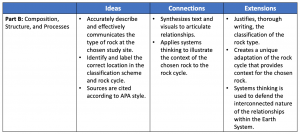5.3 Impact
Although our team of experts created a thorough description and set of instructions for the SSA assignment, many students continued to seek advice because of their dependency of following a cookbook approach that was driven towards point counting assessments. We—myself and the teaching assistants—commonly noticed students taking a prescriptive approach to their work. In these cases, these students were often challenged to conceptualize the assignment holistically through suggested strategies and interactions with myself and the teaching assistants, which meant they were encouraged to pause, reflect, and think deeply about possibilities, and strive for unique, interconnected approaches. The ICE model was a critical part of encouraging students to be open to these new ways of thinking as it supported them, for example, in a process of selecting a unique study site. Freedom to select any site in the world, although overwhelming for some, provided students with an opportunity to engage in novel, creative activity and the ways of geoscience thinking.
The ICE model formed the basis for the SSA rubric used in this assignment, providing a consistent guiding framework for students, instructors, and teaching assistants, especially important for large classes, such as Earth 121. These rubrics encouraged students to extend beyond listed instructions, tapping into their own creativity by incentivizing unique quality work and learning characterized at each phase of the rubric. Each rubric for Parts A, B, and C was intentionally created to align with different ways of thinking for geoscientists and mapped directly to ideas, connections, and extensions.
Idea generation in student work was assessed using the rubrics shown below. The rubric as an assessment tool helped students to move beyond presenting disparate ideas to experiment with creative elements. As an instructor, through my reflections and observations, I think that Connections in all three SSA rubrics motivated students to explore and experiment, striving to piece together a well-articulated context for their carefully selected rock and study site. Extensions in the ICE framework, incorporated into each SSA rubric encouraged and rewarded students for successfully creating compelling arguments independently. A compelling argument, no matter how different they may be from one another, could be evaluated consistently and accurately among the instructor and teaching assistants using the ICE framework. Diverging away from a list of items to complete, students slowly embraced the freedoms afforded by the holistic rubric, especially as we progressed from parts A to B and then C.



Through a phased approach of giving effective feedback, each in parts A, B, and then C, students demonstrated significant improvement in the quality of their thinking, which by their accounts was a result of both individual written feedback on several assignments and general listed feedback to the entire class at each stage of the SSA. The instructor and teaching assistants met during and after evaluating each stage to ensure a robust and reliable approach to giving feedback. We attempted to purposefully provide more feedback to students in Parts A and B to help them develop their deep and creative thinking and to enable improvement in this cumulative SSA assignment. A list of future considerations for the entire class was created at each stage, as well, and posted to help guide students when reflecting on their own submission after providing feedback to facilitate continuous enhancement. We challenged students to: (a) carefully read their feedback, (b) critically reflect upon their submission, and (c) thoughtfully re-examine assignment instructions and the ICE rubric to identify key areas for improvement on their own before contacting the instructor or teaching assistants.
The most significant struggle as an instructor of a large and continuously growing online class was making the case for additional and qualified teaching assistants. The rubrics I developed, based upon the ICE framework, were able to draw out deep and creative student work but I quickly realized I needed to screen and train teaching assistants to ensure they could proficiently assess and evaluate holistic submissions by students. Not only did I screen teaching assistants for subsequent offerings of this course, I added discussion and resources to better understand the ICE model (Fostaty Young 2005 and Vesely 2017). Disseminating these resources to students before assignments helped establish a frame of mind for students to extend beyond Ideas and create Connections and Extensions and help teaching assistants prepare for grading. Resources and discussions with teaching assistants evolved throughout their training and development and led to iterative improvements in the SSA.
Many teaching assistants appreciated that they could consistently evaluate unique compilations among a large class without getting “lost in the weeds” of unconnected words and sentences. During our weekly teaching assistant meetings, I often heard how easy the ICE rubric enabled the identification of good quality work and attribute a good mark for such a variety of deep and creative thinking. Many teaching assistants also mentioned that this assignment and associated rubrics improved their own writing and ability to formulate quality submissions in their classes or for their own theses and publications.
As the instructor, I have been profoundly changed by the ICE framework because of its utility in inspiring students to think deeply and autonomously as they craft unique masterpieces, wherein visuals and text come together in a synergistic manner. I believe this learning process is critical for students to engage in as we evolve as a contemporary society as it offers an opportunity to be informed about the role that each person plays in the dynamic and complex Earth system to which we belong. The ICE framework supports my personal and professional belief that we must strive to move from a surficial view to the greatest depths of the Earth and ourselves to unveil the dynamic interconnectedness that the Earth System offers to those who strive for meaning and belonging.

